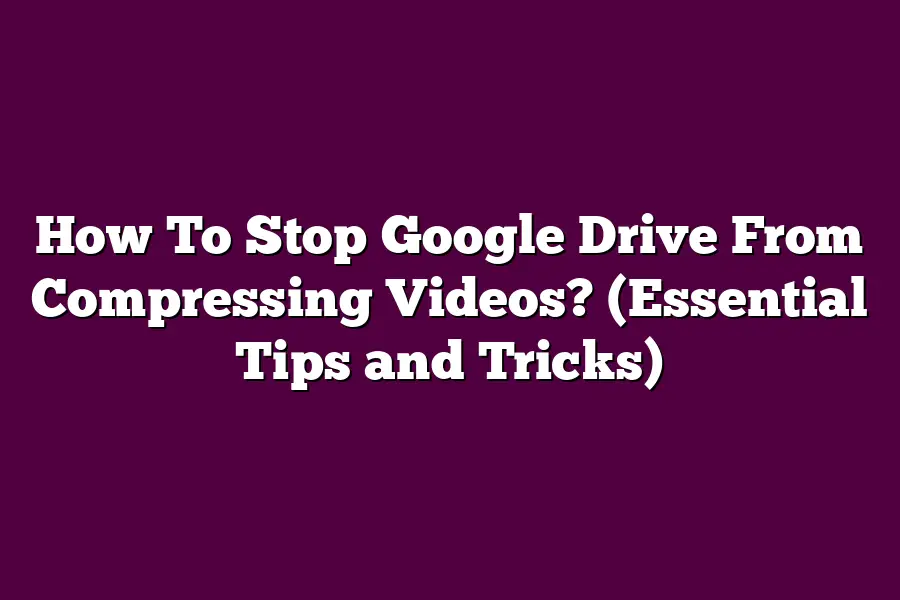To prevent Google Drive from compressing videos, you can upload your videos in their original quality by changing the upload settings. Go to Google Drive, click on the gear icon, select “Settings,” and then check the box next to “Convert uploaded files to Google Docs editor format” to disable compression. By uploading videos in their original format, you can maintain their quality without any loss due to compression.
Tired of Google Drive compressing your videos into pixelated disasters?
In this guide, I’ll share essential tips to preserve your video quality.
From supported formats to uploading tricks, we’ve got you covered.
Say goodbye to the compression zone!
Let’s get started!
Table of Contents
Supported Video Formats for Google Drive – Key Factors to Consider
Are you tired of Google Drive compressing your videos, leaving you with lower quality playback?
You’re not alone.
Understanding the supported video formats for Google Drive is crucial in maintaining the quality of your video files.
Let’s delve into the key factors you need to consider when uploading videos to Google Drive.
Supported Video Formats
When it comes to video formats, Google Drive supports a variety of file types to ensure compatibility and optimal viewing experience.
The recommended video formats for Google Drive include:
MP4: As one of the most widely used video formats, MP4 offers a good balance between video quality and file size. Google Drive handles MP4 files efficiently, allowing for smooth playback without compression issues.
AVI: Another popular format, AVI, is also supported by Google Drive. Although it may result in larger file sizes compared to other formats, AVI files maintain high video quality without compromising on resolution.
MOV: Developed by Apple, MOV files are compatible with Google Drive and retain excellent video quality. If you’re an Apple user looking to upload MOV files, you can do so without worrying about compression.
WMV: Windows Media Video (WMV) files are also supported by Google Drive. While WMV files may not be as common as MP4 or AVI, they are still a viable option if you prefer this format.
Factors to Consider
When selecting the right video format for your Google Drive uploads, consider the following factors:
Quality vs. File Size: Balancing video quality with file size is essential. Opt for formats like MP4 or MOV that offer good video quality without excessive compression.
Device Compatibility: Ensure that the chosen video format is compatible with a wide range of devices for seamless playback. Formats like MP4 are universally supported across different platforms.
Bitrate and Resolution: Pay attention to the bitrate and resolution of your video files. Higher bitrates and resolutions can impact file size and quality, so choose settings that best suit your needs.
Editing Flexibility: Consider whether you may need to edit the video files in the future. Some formats are more conducive to editing without loss of quality or compatibility issues.
By understanding the supported video formats for Google Drive and considering these key factors, you can ensure that your videos maintain their quality during storage and playback.
Choose the right format that aligns with your needs and preferences to make the most out of your video uploads on Google Drive.
In the next section, we will explore tips and techniques to avoid video compression issues on Google Drive.
Stay tuned for more insights on optimizing your video files for seamless playback.
Converting Videos to Google Drive-Friendly Formats
Are you tired of Google Drive compressing your videos into lower quality versions?
I hear you.
But fear not, there’s a solution!
By converting your videos to Google Drive-friendly formats, you can maintain the quality of your precious footage.
Let’s dive into how you can stop Google Drive from wreaking havoc on your video files.
Why You Should Convert Videos to Google Drive-Friendly Formats
Before we delve into the how, let’s first understand why converting your videos to Google Drive-friendly formats is crucial.
When you upload a video to Google Drive, it automatically compresses the file to save space.
This compression can lead to a significant loss in video quality, which is less than ideal, especially if you’re working with high-definition footage.
The Best Formats for Google Drive
To ensure that your videos remain crisp and clear on Google Drive, it’s essential to convert them to formats that are less prone to compression.
The best formats for Google Drive include:
- MP4: This widely supported format provides good quality and compression efficiency.
- MOV: Developed by Apple, MOV files are known for their high-quality video output.
- AVI: A popular format that offers excellent video quality and is compatible with most media players.
By converting your videos to these preferred formats, you can minimize the risk of Google Drive drastically reducing their quality.
How to Convert Videos to Google Drive-Friendly Formats
Now that you understand the importance of converting your videos, let’s talk about how you can do it effectively.
Here are some simple steps to convert your videos to Google Drive-friendly formats:
Choose the Right Conversion Tool: Utilize online video converters like AConvert or HandBrake to convert your videos to MP4, MOV, or AVI formats.
Adjust Settings for Optimal Quality: When converting your videos, ensure that you select the highest quality settings to maintain the integrity of your footage.
Test the Converted File: Before uploading the converted video to Google Drive, preview it to ensure that the quality meets your standards.
By following these steps, you can safeguard your videos from being compressed by Google Drive and preserve their original quality.
Wrap Up
converting your videos to Google Drive-friendly formats is a simple yet effective way to prevent quality loss when uploading your files.
By opting for formats like MP4, MOV, or AVI and following the right conversion process, you can maintain the integrity of your videos on Google Drive.
Say goodbye to blurry, pixelated footage and hello to crystal-clear visuals!
Stay tuned for more tips on optimizing your video content for seamless storage and sharing on Google Drive.
Your videos deserve to shine in all their glory, and with the right approach, you can make it happen.
Join me in the next section as we explore more strategies to enhance your video experience on Google Drive.
Uploading Videos to Google Drive: Web Interface vs. Google Drive Application
When it comes to uploading videos to Google Drive, users have two main options: using the web interface or the Google Drive application.
Each method has its own advantages and limitations, so it’s essential to understand the differences to choose the best option for your needs.
Web Interface:
On the web interface of Google Drive, users can upload videos directly through their web browser.
Here are some key points to consider:
Ease of Access: The web interface is accessible from any device with an internet connection, making it convenient for users who need to upload videos on the go.
Storage Limitations: Google Drive offers 15 GB of free storage to users. While this is sufficient for storing smaller video files, larger videos may quickly eat up your available space.
Internet Speed Dependency: Uploading videos via the web interface is dependent on your internet speed. Slow connections may result in longer upload times and potential interruptions.
Compression: Google Drive may automatically compress videos uploaded through the web interface to save storage space. This compression can affect the video quality, which may be a concern for users looking to maintain high-quality video files.
Google Drive Application:
Alternatively, users can upload videos to Google Drive using the Google Drive application on their desktop or mobile device.
Here’s what you need to know:
Syncing Capability: The Google Drive application allows for seamless syncing between your devices. This means that any videos uploaded through the application will be accessible across all your devices with the application installed.
Offline Access: With the Google Drive application, users can access their uploaded videos even when they are offline. This feature is beneficial for users who need to view videos without an internet connection.
Storage Options: While the Google Drive application still adheres to the 15 GB free storage limit, users have the option to purchase additional storage if needed for storing larger video files without compression.
Upload Speed: Uploading videos through the Google Drive application can be faster and more reliable compared to the web interface, especially for larger video files.
By understanding the differences between uploading videos via the web interface and the Google Drive application, users can make an informed decision based on their specific requirements and preferences.
Whether prioritizing convenience, storage space, or upload speed, choosing the right method can enhance the overall video uploading experience on Google Drive.
Tips and Tricks to Avoid Video Compression on Google Drive
Are you tired of your videos losing quality when you upload them to Google Drive?
You’re not alone.
Many users struggle with Google Drive’s automatic compression feature, which can diminish the quality of videos.
But fear not, as I’ve compiled some tips and tricks to help you avoid video compression on Google Drive.
1. Understand Google Drive’s Compression Limits
Google Drive has specific limitations when it comes to video uploads.
For videos longer than 14 minutes, Google Drive will compress the file, resulting in loss of quality.
Understanding these limits is crucial in maintaining the integrity of your videos.
2. Opt for the Right File Format
Choosing the correct file format can significantly impact the quality of your videos on Google Drive.
While Google Drive supports various video formats, opting for non-compressed formats like MP4 can help minimize additional compression by the platform.
3. Utilize Third-Party Compression Tools
To bypass Google Drive’s compression algorithm, consider using third-party compression tools before uploading your videos.
Tools like HandBrake or Adobe Premiere Pro can help you optimize your videos for uploading while preserving quality.
4. Split Videos into Smaller Segments
If you have a lengthy video that exceeds Google Drive’s compression threshold, consider splitting it into smaller segments.
By breaking the video into manageable parts, you can prevent automatic compression, ensuring each segment maintains its original quality.
5. Adjust Video Resolution and Bitrate
Before uploading your videos to Google Drive, adjust the resolution and bitrate settings to optimize quality.
Lowering the resolution and bitrate can help reduce file size without compromising visual integrity, allowing your videos to remain crisp and clear on the platform.
6. Upload Videos in High Definition
For optimal video quality on Google Drive, always upload your videos in high definition.
Higher resolution videos are less likely to undergo significant compression, ensuring that your content looks sharp and professional when viewed by others.
By implementing these tips and tricks, you can outsmart Google Drive’s compression algorithms and preserve the quality of your videos for viewers to enjoy.
Stay tuned for more insights on maximizing the potential of your online content!
Final Thoughts
Mastering how to stop Google Drive from compressing your videos is essential for maintaining the quality of your content.
By understanding the supported video formats, converting videos to Google Drive-friendly formats, and utilizing the Google Drive application for uploads, you can ensure your videos remain crisp and clear.
Remember, small adjustments like these can make a big difference in preserving your video quality.
Take action today by implementing these tips and tricks, and say goodbye to video compression woes on Google Drive!

